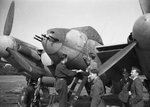Gemhorse
Senior Airman
It was a pretty 'ballsy' idea in 1938 to build a wooden aircraft as an unarmed bomber capable of outflying all contempary fighters, but DH's success with the DH 91 Albatross as a wooden airliner proved this 'wood structuring' idea. After the Mosquito's service introduction and the variant developments that evolved, I think Germany was lucky that the Mosquito's single-seat version didn't make quantity production earlier...The DH 103 Hornet was probably the fastest piston-engined aircraft of it's type produced...the prototype achieving 485 mph level-flight, back in July 1944. - It was also unique in that it was the first aircraft in the World to have wood glued successfully to metal, using 'Redux Adhesive'. Apart from having Laminar-flow wings, it was also a very successful Carrier aircraft, and the Nightfighter two-seat version was developed thru the Sea Hornet's role. The Hornet stayed in service until 1956 and settled the FAA's need for an exceptional Offensive/Defensive fighter. - Our earlier discussions concerning putting Griffon engines into Mosquitos Lightnings was interesting in the light of the Hornet's engines, Merlin 130/131's or 133/134's, capable of 2,070 2,030 hp respectively...Built essentially for the PTO, they had very long range with external tanks, and carried everything except the Molins cannons and heavy bombs of the Mosquito. But it's undeniable what a successful construction technique De Havilland had evolved using wood, principally cedar ply, sandwiching a layer of Balsa wood. - They used Birch ply on the Hornet, with reinforced Alclad, but these types of designs were and probably still are, unique in the World....Put up against ALL the metal-built aircraft, performance in all aspects is astonishing in comparison, and even with jets, the He-219 still would not have had the manoevrability....


